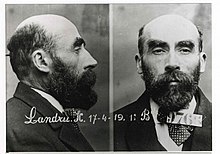Henri Désiré Landru
This article needs additional citations for verification. (January 2010) |
Henri Désiré Landru | |
|---|---|
 | |
| Born | April 12, 1869 |
| Died | February 25, 1922 (aged 52) |
| Other names | Many pseudonyms, including "Monsieur Diard" and "Dupont"[1] |
| Occupation(s) | Soldier, second-hand furniture dealer, fraudster |
| Known for | Serial killer |
Henri Désiré Landru (12 April 1869 – 25 February 1922) was a French serial killer and real-life "Bluebeard".
Early life
Landru was born in Paris. After leaving school, he spent four years in the French Army from 1887 – 1891. After he was discharged from service, he proceeded to have a sexual relationship with his cousin. She bore him a daughter, although Landru did not marry her; he married another woman two years later and had four children. He was shortly swindled out of money by a fraudulent employer. He turned to fraud himself, operating scams that usually involved swindling elderly widows. He was sentenced to two years imprisonment in 1900 after being arrested and found guilty of fraud, the first of several such convictions. By 1914, Landru was estranged from his wife and working as a second-hand furniture dealer.
Murders
Landru began to put advertisements in the lonely hearts sections in Paris newspapers, usually along the lines of "Widower with two children, aged 43, with comfortable income, serious and moving in good society, desires to meet widow with a view to matrimony." With World War I underway, many men were being killed in the trenches, leaving plenty of widows upon whom Landru could prey.
Landru would seduce the women who came to his Parisian villa and, after he was given access to their assets, he would kill them and burn their dismembered bodies in his oven. Between 1914 and 1918, Landru claimed 11 victims: 10 women plus the teenaged son of one of his victims. With no bodies, the victims were just listed as missing, and it was virtually impossible for the police to know what had happened to them as Landru used a wide variety of aliases in his schemes. His aliases were so numerous that he had to keep a ledger listing all the women with whom he corresponded and which particular identity he used for each woman.
In 1919, the sister of one of Landru's victims, Madame Buisson, attempted to track down her missing sibling. She did not know Landru's real name but she knew his appearance and where he lived, and she eventually persuaded the police to arrest him. Originally, Landru was charged only with embezzlement. He refused to talk to police, and with no bodies (police dug up his garden, but with no results), there was seemingly not enough evidence to charge him with murder. However, policemen did eventually find various bits of paperwork that listed the missing women, including Madame Buisson, and combining those with other documents, they finally built up enough evidence to charge him with murder.
List of victims
- Madame Cuchet (last seen January 1915)
- Son of Madame Cuchet (last seen January 1915)
- Madame Laborde-Line (last seen 26 June 1915)
- Madame Guillin (last seen 2 August 1915)
- Madame Heon (last seen 8 December 1915)
- Madame Collomb (last seen 25 December 1915)
- Andree Babelay (last seen 12 April 1916)
- Madame Buisson (last seen 19 August 1916)
- Madame Jaume (last seen 25 November 1917)
- Madame Pascal (last seen 5 April 1918)
- Madame Marchadier (last seen 15 January 1919)[2]
Trial and execution
Landru stood trial on 11 counts of murder in November 1921. He was convicted on all counts, sentenced to death, and guillotined three months later in Versailles. During his trial Landru traced a picture of his kitchen including the stove he was accused to have burned his victims in. He gave this drawing to one of his lawyers, Auguste Navières du Treuil. In December 1967 the drawing was made public, written in pencil on the back Landru had written "Ce n'est pas le mur derrière lequel il se passe quelque chose, mais bien la cuisinière dans laquelle on a brûlé quelque chose" (It is not the wall behind which a thing takes place, but indeed the stove in which a thing has been burned). This has been interpreted as Landru's confession to his crimes [3].
In popular culture
Landru was the inspiration for Charlie Chaplin's film Monsieur Verdoux (1947). The original story was written by Orson Welles, who originally wanted to direct the film with Chaplin in the title role. However, since Chaplin did not like to be directed by anyone but himself, Chaplin bought the story from Welles. Chaplin then wrote, directed, and starred in Monsieur Verdoux himself.
The 1960 film, Bluebeard's Ten Honeymoons, starred George Sanders as Landru.
The 1962 film Landru, directed by Claude Chabrol, was inspired by the murders.
In the 1963 episode of The Twilight Zone entitled "The New Exhibit", a wax figure of Landru plays an important role.
The case also featured in one of the episodes of the 1976 BBC series Second Verdict.
A 2005 French movie named Désiré Landru is another adaptation of this story.
In 2001, the French satirical journalist Frédéric Pagès, writing under the pseudonym Jean-Baptiste Botul, published a book entitled Landru: Precursor of Feminism (Landru, Precurseur du Feminisme: La Correspondance Inedite, 1919-1922).
Accounts in English include Dennis Barden's The Ladykiller: The Life of Landru, the French Bluebeard [4] and William Bolitho's Murder for Profit. [5]
Henri Désiré Landru's severed head is on display at the Museum of Death in Hollywood, California.[6]
